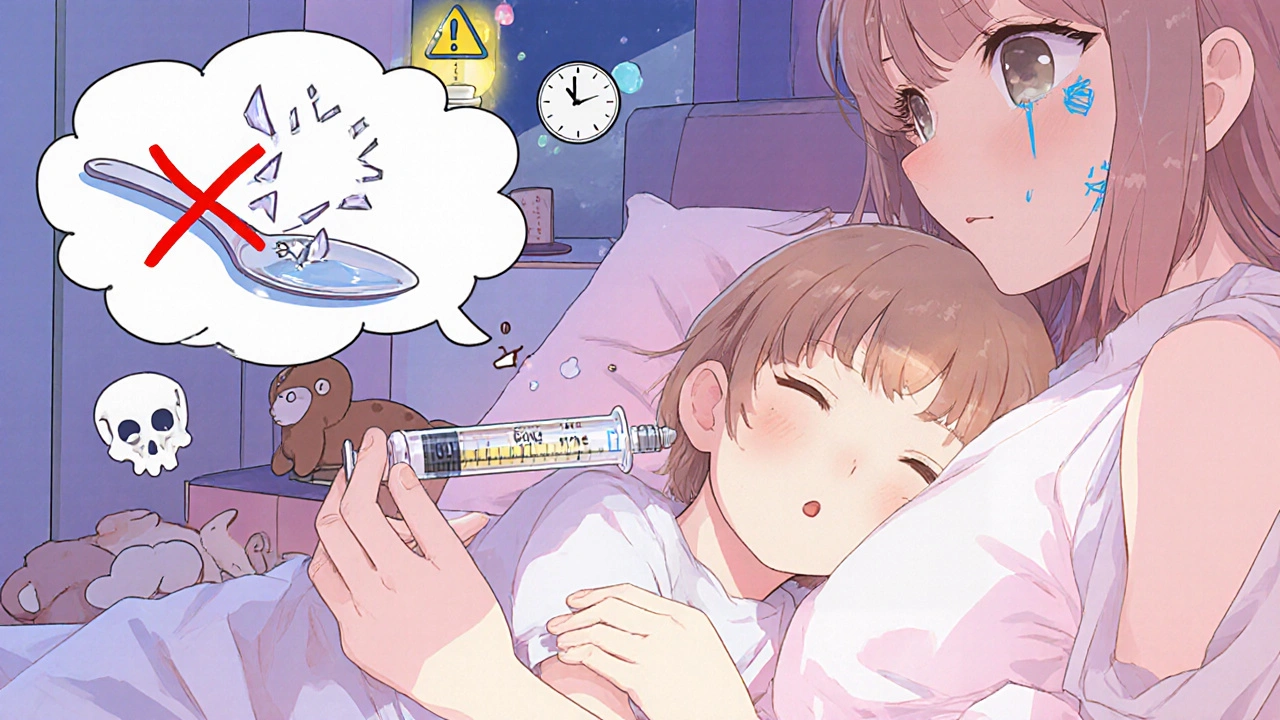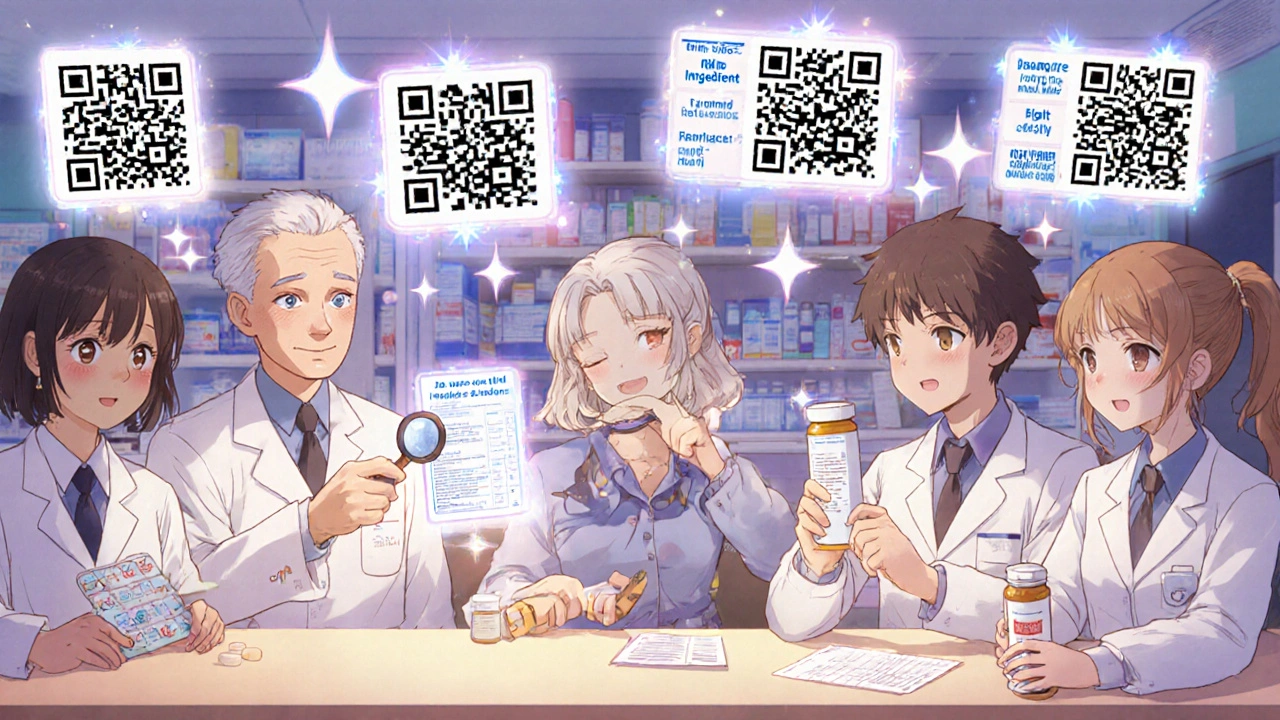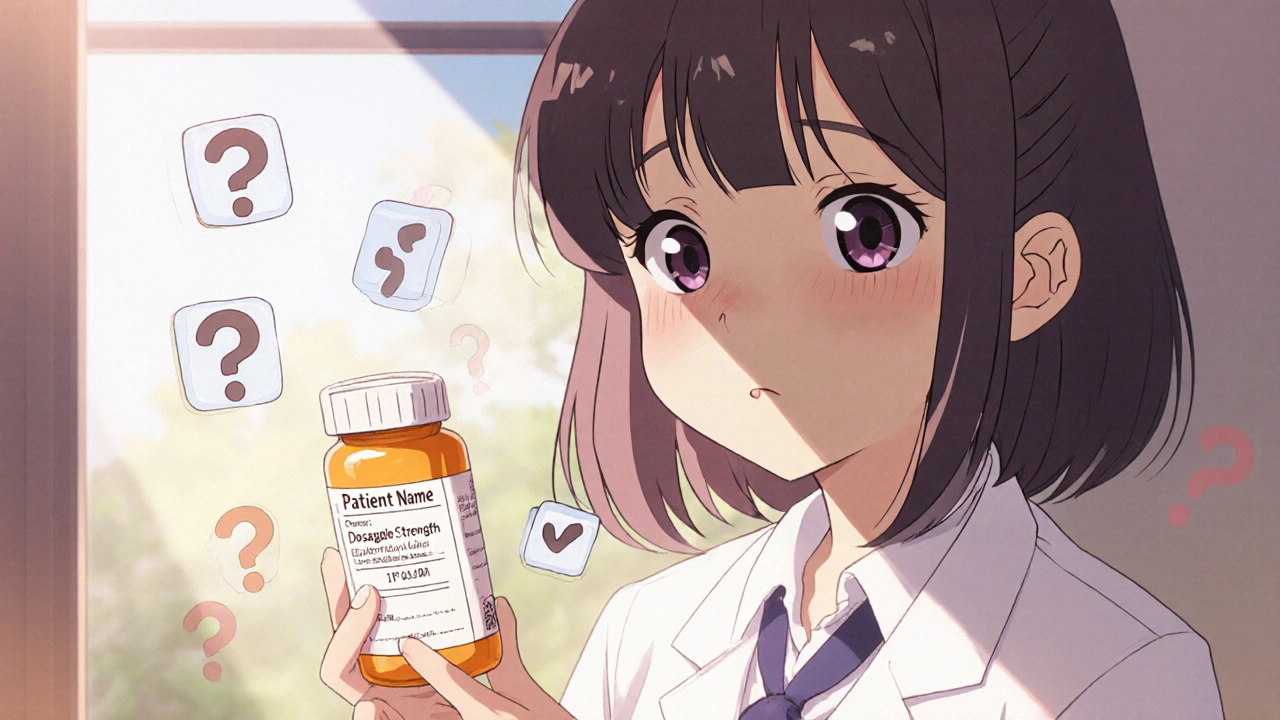Why Medication Labels Matter More Than You Think
Every year, hundreds of thousands of people in the U.S. end up in the hospital because they took medicine the wrong way. Not because the drug was bad, but because they didn’t understand the label. It sounds simple-just read the instructions-but when you’re tired, stressed, or dealing with a sick child, even clear words can get lost. Medication labels aren’t just paperwork. They’re your first and last line of defense against dangerous mistakes.
Think about this: a parent gives their child cough syrup using a kitchen teaspoon because the dosing cup is missing. That teaspoon might hold 7 mL instead of the standard 5 mL. That’s a 40% overdose. Or someone takes two different cold medicines thinking they’re helping, not realizing both contain acetaminophen. Too much of that one ingredient can cause liver failure. These aren’t rare cases. They happen every day.
The good news? Almost all of these errors are preventable. The key is learning how to read the label like a pro-not just skimming it.
What’s on a Prescription Label? The Must-Know Sections
If you’ve ever picked up a prescription, you’ve seen the small white label stuck to the bottle. It looks simple, but it’s packed with critical info. Here’s what you need to check every single time:
- Patient name - Always verify this. A mix-up here can be deadly. I’ve seen cases where someone got their spouse’s blood thinner by accident.
- Medicine name - Both the brand name (like Lipitor) and the generic (atorvastatin) should be listed. Know both. If your doctor switches brands, the active ingredient should stay the same.
- Dosage strength - This tells you how much medicine is in each pill or milliliter. A 10 mg tablet is not the same as a 20 mg tablet. Don’t assume.
- Directions - This is where most people slip up. "Take one by mouth twice daily" means two pills total per day, not one in the morning and one at night unless specified. "Take every 6 hours" means four times a day-not just when you remember.
- Dispensing pharmacy - Make sure it’s your usual pharmacy. If it’s different, double-check the prescription with them.
- Expiration date - Don’t use medicine past this date. It may not work, or worse, it could break down into something harmful.
For prescription drugs, the FDA requires 16 specific sections in the full prescribing guide. The most important one for you is Section 2: Dosage and Administration. It tells you how much to take, how often, what to do if you miss a dose, and if your kidney or liver function changes how much you need. If you’re on multiple medications, this section also warns about dangerous interactions.
How to Read an OTC (Over-the-Counter) Drug Facts Label
OTC meds like painkillers, allergy pills, or cold syrup follow a standard format called "Drug Facts." It’s designed to be easy to follow. Here’s how to break it down:
- Active ingredients - This lists what actually treats your symptoms. If you’re taking more than one OTC product, compare these lists. Many cold medicines contain the same thing-like acetaminophen or diphenhydramine. Taking two with the same active ingredient is how people overdose.
- Purpose - Tells you what the medicine does: "pain reliever," "antihistamine," "decongestant." Know what you’re taking and why.
- Uses - Lists symptoms it treats. If your symptom isn’t listed, don’t use it. That’s a red flag.
- Warnings - This section is where people skip. It tells you when NOT to take the medicine: "Do not use if you have high blood pressure," "May cause drowsiness," "Avoid alcohol." Ignoring this is the #1 reason for ER visits.
- Dosage instructions - Exact amounts, times, and maximum daily limits. "Take 2 tablets every 6 hours. Do not exceed 8 tablets in 24 hours." That’s not a suggestion. It’s a safety limit.
- Other information - Includes storage tips, inactive ingredients (for allergies), and sometimes a barcode.
One big mistake? People assume "natural" or "herbal" means safe. That’s not true. Many OTC herbal products contain hidden active ingredients that interact badly with prescription drugs. Always check the active ingredients-even on "natural" labels.

Understanding Liquid Medicines: The #1 Cause of Mistakes
Getting liquid medicine doses right is harder than it looks. Why? Because labels use measurements you don’t use every day.
Look for the concentration: "125 mg per 5 mL." That means every 5 milliliters has 125 mg of medicine. If your child needs 250 mg, you need 10 mL-not 2 teaspoons, not "a capful." A standard dosing cup has 5 mL and 10 mL marks. Use it. If you don’t have one, ask the pharmacist for a free oral syringe. They’ll give you one.
Never use a kitchen spoon. A teaspoon from your drawer can hold anywhere from 2.5 mL to 7.3 mL. That’s a huge range. A tablespoon? It can be 7 mL or 15 mL. That’s a 100% difference. One study found that 68% of parents made dosing errors with liquid medicine because they used spoons.
And here’s a real example: A patient was given a 30 mL bottle of amoxicillin labeled "250 mg per 5 mL." They thought the whole bottle was one dose. They gave it all at once. That’s 1,500 mg-six times the normal single dose. The child ended up in the hospital with vomiting and seizures. That bottle had six correct doses. The label said it. The person didn’t read it.
Special Cases: Kids, Seniors, and Multiple Medications
Some groups are at higher risk for label mistakes.
For children: Dosing is often based on weight, not age. If your child weighs 15 kg, and the label says "5 mL per 10 kg," you give 7.5 mL. Don’t guess. Use a scale. If you don’t know your child’s exact weight, ask your doctor or pharmacist. Many pediatric meds have weight-based charts on the bottle-use them.
For older adults: Many seniors take five or more medications. That’s a recipe for confusion. Use a pill organizer with clear labels. Set phone alarms for each dose. Ask your pharmacist to review all your meds together-they can spot duplicates or dangerous combos you didn’t know about.
For multiple meds: Always ask: "Do any of these have the same active ingredient?" For example, Tylenol, Excedrin, and many cold medicines all contain acetaminophen. Take too much, and you damage your liver. The FDA says the max daily dose for adults is 3,000-4,000 mg, depending on health. That’s fewer pills than you think.
The Five Rights of Safe Medication Use
Nurses follow a simple checklist called the "Five Rights" to avoid errors. You should too:
- Right patient - Is this medicine for you? Check your name.
- Right drug - Does the name match what your doctor prescribed?
- Right dose - Does the strength match what you expect? (e.g., 10 mg, not 20 mg)
- Right route - Is it meant to be swallowed, injected, or applied to the skin? Don’t swallow a cream.
- Right time - Are you taking it at the right intervals? "Every 8 hours" means 3 times a day, evenly spaced.
If you can’t answer all five, don’t take it. Call your pharmacy or doctor. Better safe than sorry.

What’s Changing? The Future of Medication Labels
Labels are getting smarter. In 2024, the FDA started testing QR codes on medicine packages. Scan one, and you get a video showing how to take the drug, an interactive dose calculator, and a list of side effects in plain language.
By 2027, most countries plan to use color-coding and icons for high-risk drugs. Red = high alert. A skull = toxic if misused. A clock = take at the same time daily. These aren’t just pretty designs-they’re visual cues that help people who struggle with reading.
And the language is changing. Instead of "take on an empty stomach," you’ll see "take 1 hour before food." Instead of "use with caution," you’ll see "do not take if you have kidney disease." Clear, simple, direct.
What to Do If You’re Still Confused
You’re not alone. If the label doesn’t make sense, don’t guess.
- Call your pharmacy. Pharmacists are trained to explain labels. They have time to walk you through it.
- Ask your doctor to write down the instructions in plain language.
- Use the FDA’s website or BeMedWise for free guides on reading labels.
- Take the bottle with you to appointments. Show it to your doctor or nurse.
There’s no shame in asking. The biggest danger isn’t not knowing-it’s thinking you know when you don’t.
Final Checklist: Before You Take Any Medicine
Before you swallow, tap these five things:
- ✅ Is this medicine for me? (Check name)
- ✅ Do I know the strength? (10 mg, not 20 mg)
- ✅ Do I know how much to take? (2 tablets? 5 mL?)
- ✅ Do I know how often? (Every 6 hours? Once daily?)
- ✅ Did I check for duplicates? (Is this the same as another pill I’m taking?)
If you can say "yes" to all five, you’re safe. If not, stop. Call someone who can help.
Medication labels aren’t meant to be confusing. They’re meant to protect you. When you take the time to read them, you’re not just following rules-you’re saving your own life.
What should I do if I miss a dose?
Check the label first. Some medicines say "take it as soon as you remember," while others say "skip it and wait for the next dose." Never double up unless the label says it’s safe. If you’re unsure, call your pharmacist. Taking too much can be dangerous, especially with blood thinners, insulin, or seizure meds.
Can I crush or split pills if they’re hard to swallow?
Only if the label says it’s okay. Many pills-especially extended-release ones-are designed to release medicine slowly. Crushing them can cause too much medicine to hit your system at once. Time-release capsules should never be opened. Always ask your pharmacist before altering a pill.
Why do some labels say "take with food" and others say "take on an empty stomach"?
Some medicines work better with food-it helps them absorb or reduces stomach upset. Others need an empty stomach to be absorbed properly. If you take an antibiotic like amoxicillin with dairy, it might not work as well. If you take a thyroid pill with coffee or calcium, it won’t absorb. Follow the label exactly.
How do I know if a medicine has expired?
Look for the expiration date on the bottle or box. It’s usually printed as MM/YYYY. After that date, the medicine may not work as well, or it could break down into something harmful. Don’t use it-even if it looks fine. For liquid antibiotics, discard after 14 days even if the date is later. They lose potency fast.
What if the label looks different from last time?
That’s normal. Pharmacies sometimes switch suppliers, and the label design changes. But the active ingredient, strength, and directions should stay the same. Always compare the name, dosage, and instructions. If anything looks different-like a new warning or a changed dose-call your pharmacist before taking it.
Are generic medicines as safe as brand names?
Yes. Generic medicines must meet the same FDA standards as brand names. They contain the same active ingredient, strength, and dosage form. The only differences are in color, shape, or inactive ingredients-which rarely matter. But always check the label to make sure the generic matches what your doctor prescribed.


vinod mali
November 18, 2025 AT 06:21Georgia Green
November 20, 2025 AT 05:26Rob Goldstein
November 21, 2025 AT 22:00Kathy Grant
November 23, 2025 AT 00:24Robert Merril
November 24, 2025 AT 05:07Jennie Zhu
November 24, 2025 AT 16:29Roberta Colombin
November 26, 2025 AT 01:03Dave Feland
November 26, 2025 AT 12:04Ashley Unknown
November 27, 2025 AT 23:11Christina Abellar
November 28, 2025 AT 21:50Eva Vega
November 30, 2025 AT 08:50Rob Goldstein
November 30, 2025 AT 12:17Noel Molina Mattinez
December 1, 2025 AT 11:10